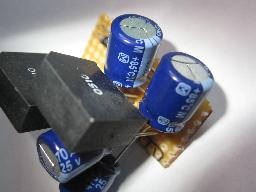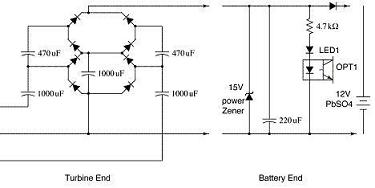Whether you make your own small DIY wind turbine alternator or use a stepper motor to generate electricity, one common problem is that the generated voltage is too low to be used to charge a 12 Volt battery.
In our article stepper motor voltage doubler circuit we present one way in which the voltage of three phase AC electricity from a stepper motor can be increased at the same time as rectifying the output into DC electricity which can be used to charge a battery.
In this article we will present a more advanced circuit which can take low voltage three-phase AC electricity inputs (of around 5 VAC) and rectify them into pulses of 15V DC electricity which can be used to charge a 12V lead acid battery. This circuit is perfect for use with Sturmey-Archer Dynohubsand other 6 Volt dynohubs which are commonly used in small DIY wind turbines powered by homemade PVC wind turbine blades.
Cockcroft-Walton Turbine Voltage Multiplier
The image above shows the circuit diagram for the Cockcroft-Walton three phase turbine voltage multiplier. Click on the image to view the original full size version. This circuit was designed to operate with a 1 Watt 5 Volt AC output three phase mini horizontal axis wind turbine (HAWT).
Since a 12V battery needs at least 12.5-14 Volts DC charging voltage, the circuit is designed as a voltage quadrupler. Because voltage is dropped in the diodes, the net result is a working voltage tripler which converts 5 Volt RMS AC elecricity into pulses of around 15 Volts DC.
The diodes used in the circuit are standard 1N4001 diodes rated at 1 Amp current at up to 50 Volts. The capacitors used should ideally be rated at 3x the peak output AC voltage of the turbine, however, since a 15V zener diode is used to clamp the maximum voltage, cheaper 16V-rated* capacitors could be used.
Excess power in the system (voltage spikes of over 15V) is dissipated by the power zener diode. The zener used must have a power rating in excess of the absolute maximum power output of the turbine (e.g. a 2 Watt or 5 Watt power zener diode for a 1 Watt rated turbine).
* It should be noted that 16V-rated capacitors could be destroyed if the power zener diode fails or is disconnected accidently.
The component labelled OPT1 is an opto-isolator included to enable a computer to track when power is being sent to the batteries (and which can of course be omitted if not required). The LED (labelledLED1) is used to give a visual indication of when current pulses are reaching the batteries, with the 4.7k resistor ensuring that the current available to the LED is very low so little power is wasted.

Instead of using individual diodes, a pair of bridge rectifiers can instead be used as shown in the photograph above.
Find out More
For more information about this three phase voltage multiplier and its usage with a micro wind turbine generator, click here to read about London Home Wind Power Pilot Project on the excellent Earth Notes website.
